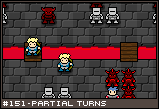|
Mechanic #151 - Partial Turns |
 | Posted: 05/09/12
An action point turn-based tactics game in which units make take partial turns if they are near units making an activation. |
![[partial1.png]](set08/img/entry151-partial1.png)
Fig 151.1 - A somewhat typical turn-based tactics game.
The foundation of this concept is a turn-based tactics game employing action points. Simply put, each unit has a pool of action points and every action they perform requires one or more action points. For instance, each square the unit moves requires an action point. Making a simple attack takes 10 action points. A heavy attack may take 15 action points. The unit may move and attack multiple times, as long as it has action points left. Each activation requires at least 5 AP, so even if the unit sits there and performs no action, some AP is used.
![[partial2.png]](set08/img/entry151-partial2.png)
Fig 151.2 - The activation queue is based on AP refill rates.
Each unit has a rate at which their AP refills (typically one AP per one tick). The unit may become activated again once its AP pool has completely filled up. This means that the more AP a unit uses, the longer they must wait for their next turn. It also means that units with smaller AP pools will activate more often, though can perform fewer actions per activation. Ultimately, this leads to an activation queue where you can see which units should activate and in which order, based on how much AP they must refill and their refill rate.
![[partial3.png]](set08/img/entry151-partial3.png)
Fig 151.3 - Units also activate neighboring friendly units, regardless of AP pool.
Typically, units may only activate once their AP pool is filled. However, if they are standing next to a friendly unit that activates, they may choose to activate too if they have at least 5 AP. These units may move directly after the prime activated unit, potentially giving the player a few "free" turns. However, the sub-activations will start their "free" turn with whatever AP they currently have built up (minus the 5 for activation), so they may not be able to perform many actions. Units do not have to activate, and thus do not incur the 5 AP activation fee, continuing to build up AP at a normal rate.
In addition to this, units can have special support powers that affect neighboring units. A commander might increase the AP gain to 2 AP per tick for all neighboring units. A seductress could give a bonus 5 AP to neighboring male units that choose to activate with her. A particularly mobile enemy could get a free 5 AP bonus that may only be applied towards movement and not attacking. Another unit may slow enemy AP gain, while yet another could explode when defeated, draining 5 AP from all units in a two square radius. The drill sergeant could get 110% by increasing the AP pool size of friendly units on the board by 10% - making activations take longer, but giving them more to do in a single turn.
Basically, action points represents a somewhat common trope in turn-based games, but rarely is anything done with the action points themselves. The premise behind this idea is that you can manipulate the battlefield's turn order based on how units are positioned, and what affects they have on neighboring units. This ranges from early activations to modifications to the efficiency and capabilities of the AP system. |